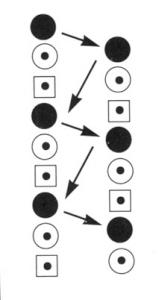By using this diagram (Figure 6), it is immediately apparent that all odd valued throws must cross sides, and that the evens never do. Also, it is apparent that even throws are like the throws you do when you juggle n/2 in one hand. (A 6 is a 3-in-one-hand throw for one throw, for example.) If the juggler does a black ball, a white one and a cube in a cascade, we can follow them on the diagram.
It
now gets a 5, then a 1, then a 5, then a 1. The notation for
a three ball shower is 5 1 (repeated). This trick has a word length
of two. We see two things here. First, that a 1 is what you do in a
shower - a quick handoff from hand to hand that's never really
airborne. That's OK. If it's a 1, there doesn't need to be
room for anything else. Second, we get an idea why the shower is so
hard for many beginning jugglers. The high throws are 5s. For a
given rate of throwing, 5s are a lot higher than 3s - not 5/3 as
high but more like 4 or 5 times as high! (Assuming gravity; this
result is from physics, not intrinsic to the notation.)
Besides
the 1, a couple of other throws need to be mentioned. First,
there is the 0. It means you aren't doing any (for that throw). Your
hand is empty. If you flash all three high, say, and pirouette under
them with empty hands, those empty hands are 0s. This is the 5 5 5 0
0. (The word length here is five.) Remember our typist a little
while ago? He had to type the spaces. A 0 is the juggler's pause, or
space, in this notation.
The other throw that might not be readily apparent is the 2. This is the kind of throw you'd do when you juggle two (in two hands, remember!) - just one in each hand. Now, in principle, you could let go of them, and throw them up a little bit, but since nothing else visits the hand in the meantime, there is no need to, you can just hold on to them and say you're juggling them. Let's try the pirouette again, but this time go around holding one in each hand - "throwing" some 2s. Now we only need to get rid of one ball with a high throw, and take the other two around with us. This is the 5 2 2. (Really it's the 3 3 3 3 3 5 2 2 3 3 3 3 if you do it once in a long run of the cascade, but you can also run the 5 2 2, by doing 5 2 2 5 2 2 5 2 2 ...etc.
This pattern looks like the three cascade, done more slowly, and higher. Then why is the notation different? Because now you are doing three notation throws per real throw, your handspeed is actually three times faster than it looks, which would be apparent if you went back to the 3 3... pattern. Then your handspeed really would be three times faster.)
|



